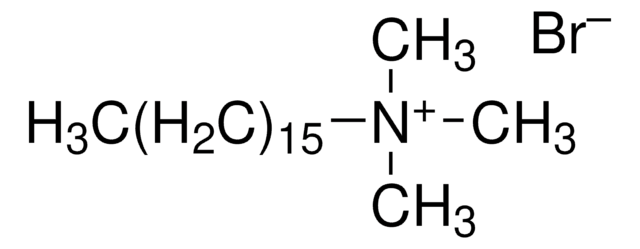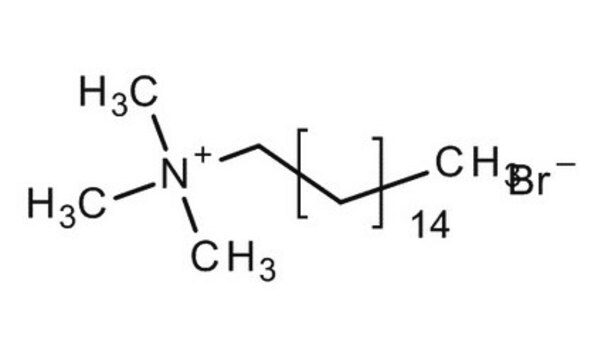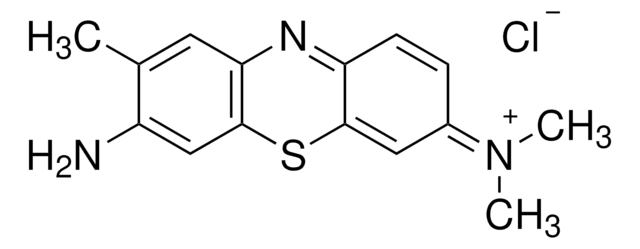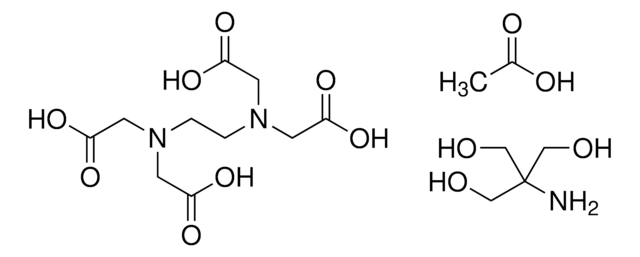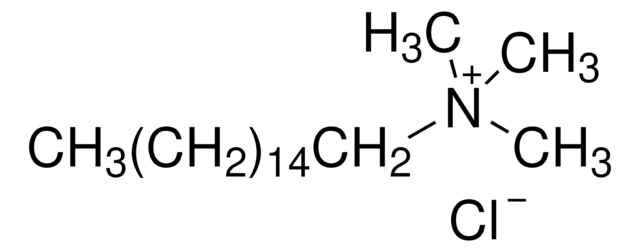52365
Esadeciltrimetilammonio bromuro
BioUltra, for molecular biology, ≥99.0% (AT)
Sinonimo/i:
CTAB, Cetiltrimetilammonio bromuro, Cetrimonio bromuro, Palmitiltrimetilammonio bromuro
About This Item
Prodotti consigliati
Grado
for molecular biology
Livello qualitativo
Descrizione
cationic
Nome Commerciale
BioUltra
Saggio
≥99.0% (AT)
Stato
powder or crystals
PM
micellar avg mol wt 62,000
Numero d'aggregazione
170
Impurezze
DNases, none detected
RNases, none detected
insoluble matter, passes filter test
phosphatases, none detected
proteases, none detected
Residuo alla calcinazione
≤0.2%
Perdita
≤0.5% loss on drying
pH
5.0-7.0 (25 °C, 0.1 M in H2O)
CMC
0.92
1 mM (20-25°C)
Punto di fusione
248-251 °C (lit.)
Solubilità
H2O: 0.1 M at 40 °C, clear, colorless
Anioni in tracce
sulfate (SO42-): ≤50 mg/kg
Cationi in tracce
Al: ≤5 mg/kg
Ba: ≤5 mg/kg
Bi: ≤5 mg/kg
Ca: ≤10 mg/kg
Cd: ≤5 mg/kg
Co: ≤5 mg/kg
Cr: ≤5 mg/kg
Cu: ≤5 mg/kg
Fe: ≤5 mg/kg
K: ≤50 mg/kg
Li: ≤5 mg/kg
Mg: ≤5 mg/kg
Mn: ≤5 mg/kg
Mo: ≤5 mg/kg
Na: ≤50 mg/kg
Ni: ≤5 mg/kg
Pb: ≤5 mg/kg
Sr: ≤5 mg/kg
Zn: ≤5 mg/kg
Stringa SMILE
[Br-].CCCCCCCCCCCCCCCC[N+](C)(C)C
λ
0.1 M in H2O
Assorbanza UV
λ: 260 nm Amax: 0.06
λ: 280 nm Amax: 0.05
HLB
10
InChI
1S/C19H42N.BrH/c1-5-6-7-8-9-10-11-12-13-14-15-16-17-18-19-20(2,3)4;/h5-19H2,1-4H3;1H/q+1;/p-1
LZZYPRNAOMGNLH-UHFFFAOYSA-M
Cerchi prodotti simili? Visita Guida al confronto tra prodotti
Applicazioni
Avvertenze
Danger
Indicazioni di pericolo
Consigli di prudenza
Classi di pericolo
Acute Tox. 4 Oral - Aquatic Acute 1 - Aquatic Chronic 1 - Eye Dam. 1 - Skin Irrit. 2 - STOT RE 2 Oral - STOT SE 3
Organi bersaglio
Gastrointestinal tract, Respiratory system
Codice della classe di stoccaggio
11 - Combustible Solids
Classe di pericolosità dell'acqua (WGK)
WGK 3
Punto d’infiammabilità (°F)
471.2 °F - closed cup
Punto d’infiammabilità (°C)
244 °C - closed cup
Dispositivi di protezione individuale
dust mask type N95 (US), Eyeshields, Faceshields, Gloves
Scegli una delle versioni più recenti:
Possiedi già questo prodotto?
I documenti relativi ai prodotti acquistati recentemente sono disponibili nell’Archivio dei documenti.
I clienti hanno visto anche
Il team dei nostri ricercatori vanta grande esperienza in tutte le aree della ricerca quali Life Science, scienza dei materiali, sintesi chimica, cromatografia, discipline analitiche, ecc..
Contatta l'Assistenza Tecnica.